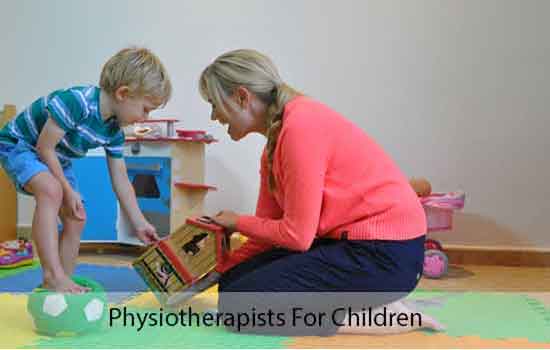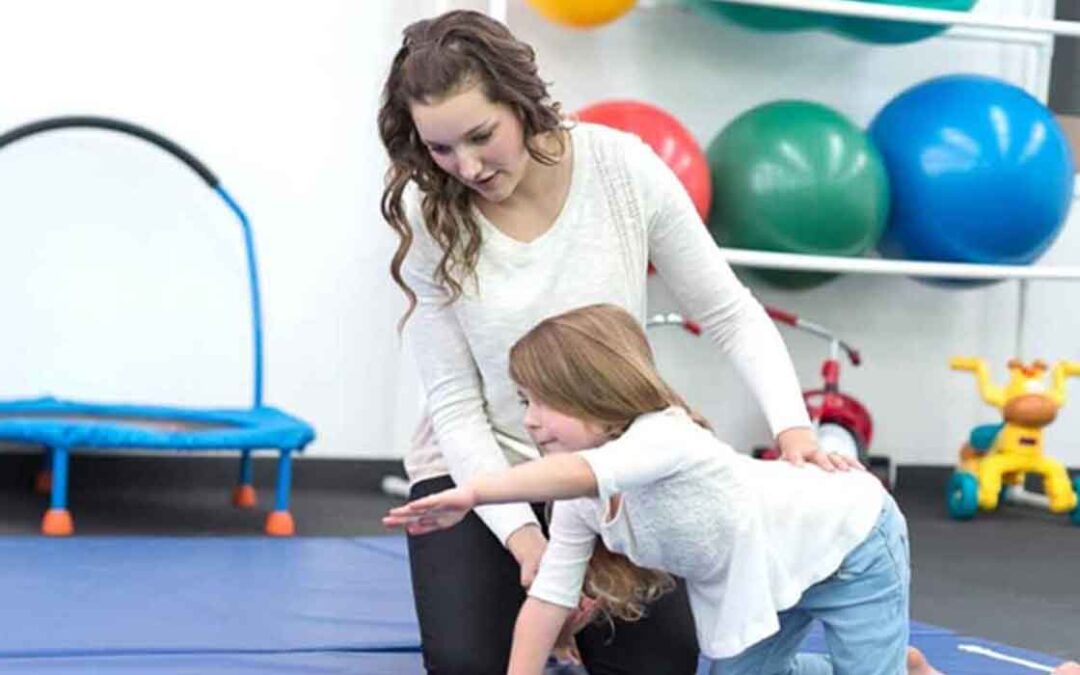Physiotherapists for children

Childhood education plays an important role in cognitive thereby affecting their mental as well as physical development. It includes sensory, cognitive, and motor development. Moreover, it involves both basic care and a change in attitude from living only in the family environment to an increase of social ties. Also, most of the sensory, cognitive, and motor learning occurs in the early five years of life.
This period brings great challenges for families, healthcare, and education professionals,. This is true especially when the child does not respond according to typical development as required. It signifies some delay in the performance of their sensory, cognitive, and motor functions as well as development.
There are certain key points which are studied concerning that child:-
- Observing the child’s behavior and noting down the child’s skills and the difficulties.
- Next, promoting such activities that can help the child to improve their ability to understand the present condition and stimulate new learning.
- In the end, engaging with the children together and actively exchanging information with their families, school, and health care and education professionals.
Also, remember that physical therapists or physiotherapists carry out physiotherapy to stimulate the inclusion of children with disabilities starting from the school environment.
What is physiotherapy?
Physiotherapy aims at helping children to develop and maintain their mobility skills, joint range of movement, muscle strength, and motor skills.
Who are Physiotherapists?
Physiotherapists are the direct connection between healthcare and education communities. The physiotherapist is a part of the therapy team that is available to see children in schools. They advise on activities to help to improve their access to the curriculum. Therapists work throughout the year. This means that they are available during the school holidays.
What do they do?
They can provide information on various conditions, conduct/interpret reports. Additionally, they can also improve communication between healthcare and education professionals, and assist in access to health resources. Physiotherapists can also provide education professional’s information on interventions for children with disabilities.
Physiotherapists must know the rights of these children. It should be kept in mind that school enrollment is just the first step. It is important to make several visits to evaluate the school environment and detect possible barriers and plan solutions. Physiotherapists should analyze school activities. This is done to better understand the skills, possible challenges in the students’ interaction, and ways to minimize these difficulties using Physiotherapy for children .
They must hold meetings with the school staff, other healthcare professionals, and families to establish the goals.
Physiotherapists should work with other professionals to establish guidelines and specific modifications for the transportation of children with disabilities. This is done to allow the acceptance of these students with disabilities by their peers. Planning projects for accessibility in recreational areas.
Collaborating with physical education teachers to develop inclusive motor development programs and participating in various prevention activities.
The creation of screening programs for musculoskeletal changes and guidance programs should be promoted. To have the best development in the child which is crucial, everyone must be working together including children, families, and health and education professionals. Further access to information, through conversation, encourages reflection and helps to prevent prejudice and discrimination also important. Consecutively, it’s important to allow the right of every child access to education according to laws and public policies guide.
What do students with special needs mean?
- There is a delay in achieving their motor milestones
- They have an identified neurological/ rheumatology conditions
- They show some difficulties with balance and coordination that affect their academic achievements and activities of the daily routine
- There is a delay in their physical abilities
- They require physical rehabilitation following injury, medical condition, or surgery.
Various physical impairments can result in Gross motor Skills defects in people with an intellectual disability. These include altered muscle tone such as quadriplegic or diplegic hypertonia, as occurs in central nervous system diseases such as cerebral palsy. Also, this might affect the level of physical activity help physiotherapy for children
Here are some physical skills which physiotherapy can improve
- Gross motor delay
- Autism Spectrum Disorder
- Cerebral Palsy
- Developmental Coordination Disorder
- Down Syndrome
- Spina Bifida
- Acquired Brain Injury
- Hypotonia
- Muscular Dystrophy or other neuromuscular challenges
- Torticollis/Plagiocephaly
- Other genetic disorders
- Weight challenges
- Athletes
How does therapy work?
To allow children the best opportunities to exercise and extend their physical skills, children should play in diverse playground equipment. This may help maintain their interest throughout the stage of psychomotor or physical development. Likewise, this is the physical activity that can contribute to the development of a child’s academic understanding by integrating movement experiences. Such physical characteristics of people in different age groups differ. Therefore, the motor or physical activities recommended for each of these age groups also differ from each other.
There are three fundamental movement abilities:
- Locomotion movement abilities: This is the ability of the body is transported in a horizontal or vertical direction from one point to another. Like running, walking, etc.
- Manipulative movement abilities: This is the ability of them to give force to an object or receiving force from an object. Like kicking, catching, etc.
- Non-Locomotor movement abilities: This is when an individual body remains in place but moves around its horizontal or vertical axis. Also, this includes twisting, bending, etc.
Age 6-7 years
Physical Characteristics:
Eye to hand coordination is always difficult. The body balance does not develop as it should be,. Also, muscle coordination is difficult, and reaction time is slow. Hence, here are some recommended activities for Physiotherapy for children :
- Specially applying force and reacting to forces like throwing and catching balls at a distance of about ten feet.
- Forward jumping with a distance of own height.
- Jumping from a height of 3 feet approx. and landing on both feet knees without losing balance.
- Rolling forward and backward.
- Games like hide and seek.
- Simple dance in physical activities.
Age 8-9 years
Physical Characteristics:
They are exceptionally active, lively, endurance is much progressed. The kids have better-developed coordination progressed eye-hand coordination. Also, they have direct but consistent development. Hence, here are some recommended activities:
- Interested in team games
- Chase games
- Rhythmic activities
Age 8-9 years
Physical Characteristics:
Physical growth is rapid, energetic with limited endurance, girls develop faster than boys. And, there is an improvement in muscle coordination. Following are some recommended activities:
- Team games including moderate complex rules.
- Tournament participation
- Individual and dual sports
- Gymnastics activities
- Aquatic sports like swimming
The term “eye-hand coordination” and “eye-foot coordination” are common in the teachings of the physical teachers. This usually show the reliance on effective development. However, each child develops these abilities at his or her rate. Not all children are at the same perceptual capacity level upon entering the primary grade. As a result, recognition status is a critical viewpoint of total readiness for learning.
A well planned physical activity program that incorporates appropriate movement experiences that contribute to the development of the young child’s perceptual abilities.
Neuromuscular ability advancement is one of a kind contribution of physical movement to the well-being of the child. Furthermore, the teacher of young children is concerned with enhancing their fundamental abilities to move acceptably in a wide variety of ways physiotherapy for children.
The role of the educator in neuromuscular ability improvement is to:
- recognize learning readiness
- motivates the learner
- further, provide a climate conducive to learning
- Use educating approaches reasonable to the individual child.
Improvement in exhibitions in fundamental development patterns and common development abilities come with practice beneath the course of an instructor talented in executing each of the above criteria. Additionally, exercise affects the vital organs of the body. Through the activity, the rate and force of heartbeats increases breathing becomes deeper and more rapid. Also, the production of body heat and waste rises, appetite and sleep improve, and accelerated energy build-up and breakdown results. Also remember that, in children, physical activity catalyzes growth.
The term learning is common to everyone’s vocabulary.
It is a fairly common term that anyone may apply to numerous situations. Additionally, an individual learns many things, including observable acts, as required in motor and verbal performances, and non-observable acts, which include values, emotions, and attitudes. Habits, bad as well as good are easy for the mind of the child. Also, learning does not even have to be intentional.
This is evident usually in diverse conditions as performing athletic skills, remembering past situations, disliking opponents in a game, and believing in the team. Also, motor learning is a relatively permanent change in the performance of a motor skill resulting from practice or experience. Further, moving on, it could be a term to depict an alteration of responses to a few natural circumstances. Also, it could be an impressive part of which comprises of designed strong compressions, both static and dynamic.
How can one makes a referral and what to do after that?
Following consent from the parents, a referral uses the Single Agency Referral Form. When the appropriate therapist can see the child, an appointment to a clinic or the therapist will arrange to visit the school. After the physiotherapist carries out an assessment. Additionally, they write a report for the parents, school (with parental consent). Also, they give advice based on the report. They carry out training for teaching assistants. Also, the therapist provides equipment that allows the child to be mobile e.g. walking frames, wheelchairs. They also advise on postural management.
When can we discharge the child?
The child will be discharged from Physiotherapy according to the discharge criteria for the service. This includes:
- No further intervention is necessary
- They have been on review for 1 year and maintained their level of ability.
- Moreover, it has not been possible to carry out the program set by the therapist.
- The child or parents no longer wish to receive physiotherapy.
Discharge procedures will are usually in line with educational policies regarding annual reviews.
Conclusion
Summing it up, the contribution of physical activities is more towards the total development of the child. Further, a program of physical activity can be an important part of the routine. Also, children must engage in physical activity that leads to the progressive development of motor skills.
Some of this activity leads to skills in functional tasks such as running, jumping, kicking, and throwing and other motor activities lead to the acquisition of fine motor skills that involve eye-hand coordination.
Subsequently, for effectiveness and adequacy in body development, all the parts of the body must work together concordantly through physical exercises. Also, sensory modalities like vision, touch, feel, come into play. Furthermore, it is time, which we call pointless play experiences of children can be seen within the light of their potential instructive value. Likewise, motor development must be in the proper perspective in the education of children, for it plays an integral part of their total growth and development.



